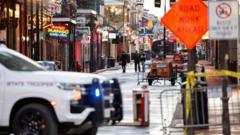In the early hours of New Year's Day, a truck veered into a crowd in the French Quarter, resulting in 14 deaths and over 35 injuries. The suspect, identified as 42-year-old Shamsud-Din Jabbar from Texas, was also killed in the incident, which has been labeled an act of terrorism by the FBI. Prior to the tragic event, the concrete and metal bollards, designed to restrict vehicles from pedestrian zones, were under renovation due to malfunctions linked to debris from local festivities, specifically Mardi Gras beads.
New Orleans Police Chief Anne Kirkpatrick revealed that measures intended to mitigate risks were in place, such as a police vehicle stationed to block access to Bourbon Street, yet the assailant maneuvered around it. The city had discussed security enhancements ahead of the Super Bowl scheduled for February 9, but Chief Kirkpatrick acknowledged that the enforcement plan was ultimately evaded by the attack. Governor Jeff Landry confirmed that additional safety protocols will be implemented for events surrounding the Sugar Bowl, indicating that Bourbon Street would reopen soon after the incident.
Mayor LaToya Cantrell noted that the deployment of bollards began over a decade ago, aimed at improving public safety in the historically frequented area. However, maintenance issues led to the decision to replace them shortly before the Super Bowl. The urban landscape of New Orleans has been identified by federal reports as a potential target for terror attacks given its densely populated pedestrian zones, emphasizing the ongoing vulnerability of the area.
Experts, like University of Michigan’s counterterrorism professor Javed Ali, expressed uncertainty about whether the presence of functioning bollards would have significantly altered the outcome of the event, indicating that the speed and momentum of the vehicle might have breached any obstacles regardless.
The recurrence of such tragedies raises a critical question regarding urban safety measures in the face of evolving threats, as cities around the globe continue to assess and implement protective strategies in public spaces.
New Orleans Police Chief Anne Kirkpatrick revealed that measures intended to mitigate risks were in place, such as a police vehicle stationed to block access to Bourbon Street, yet the assailant maneuvered around it. The city had discussed security enhancements ahead of the Super Bowl scheduled for February 9, but Chief Kirkpatrick acknowledged that the enforcement plan was ultimately evaded by the attack. Governor Jeff Landry confirmed that additional safety protocols will be implemented for events surrounding the Sugar Bowl, indicating that Bourbon Street would reopen soon after the incident.
Mayor LaToya Cantrell noted that the deployment of bollards began over a decade ago, aimed at improving public safety in the historically frequented area. However, maintenance issues led to the decision to replace them shortly before the Super Bowl. The urban landscape of New Orleans has been identified by federal reports as a potential target for terror attacks given its densely populated pedestrian zones, emphasizing the ongoing vulnerability of the area.
Experts, like University of Michigan’s counterterrorism professor Javed Ali, expressed uncertainty about whether the presence of functioning bollards would have significantly altered the outcome of the event, indicating that the speed and momentum of the vehicle might have breached any obstacles regardless.
The recurrence of such tragedies raises a critical question regarding urban safety measures in the face of evolving threats, as cities around the globe continue to assess and implement protective strategies in public spaces.




















